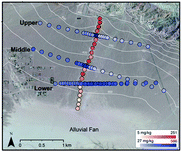This month sees the following articles in the Journal of Environmental Monitoring that are in the top ten most accessed:
Radioactive fallout in the United States due to the Fukushima nuclear plant accident
P. Thakur, S. Ballard and R. Nelson
J. Environ. Monit., 2012, 14, 1317-1324
DOI: 10.1039/C2EM11011C
Potential impacts of disinfection processes on elimination and deactivation of antibiotic resistance genes during water and wastewater treatment
Michael C. Dodd
J. Environ. Monit., 2012, 14, 1754-1771
DOI: 10.1039/C2EM00006G
The release of engineered nanomaterials to the environment
Fadri Gottschalk and Bernd Nowack
J. Environ. Monit., 2011, 13, 1145-1155
DOI: 10.1039/C0EM00547A
Environmental and biological monitoring of benzene in traffic policemen, police drivers and rural outdoor male workers
Manuela Ciarrocca, Francesco Tomei, Tiziana Caciari, Assunta Capozzella, Lara Scimitto, Nadia Nardone, Giorgia Andreozzi, Barbara Scala, Maria Fiaschetti, Carlotta Cetica, Valeria Di Giorgio, Maria Pia Schifano, Gianfranco Tomei and Angela Sancini
J. Environ. Monit., 2012, 14, 1542-1550
DOI: 10.1039/C2EM30120B
Characterization and environmental implications of nano- and larger TiO2 particles in sewage sludge, and soils amended with sewage sludge
Bojeong Kim, Mitsuhiro Murayama, Benjamin P. Colman and Michael F. Hochella
J. Environ. Monit., 2012, 14, 1129-1137
DOI: 10.1039/C2EM10809G
Distribution and risk assessment of organochlorine contaminants in surface water from River Chenab, Pakistan
Syed Ali-Musstjab-Akber-Shah Eqani, Riffat Naseem Malik, Athanasios Katsoyiannis, Gan Zhang, Paromita Chakraborty, Ashiq Mohammad and Kevin C. Jones
J. Environ. Monit., 2012, 14, 1645-1654
DOI: 10.1039/C2EM11012A
The antibacterial effects of engineered nanomaterials: implications for wastewater treatment plants
Ndeke Musee, Melusi Thwala and Nomakhwezi Nota
J. Environ. Monit., 2011, 13, 1164-1183
DOI: 10.1039/C1EM10023H
Planning for sustainability in China’s urban development: Status and challenges for Dongtan eco-city project
Hefa Cheng and Yuanan Hu
J. Environ. Monit., 2010, 12, 119-126
DOI: 10.1039/B911473D
Quantitation of persistent organic pollutants adsorbed on plastic debris from the Northern Pacific Gyre’s “eastern garbage patch”
Lorena M. Rios, Patrick R. Jones, Charles Moore and Urja V. Narayan
J. Environ. Monit., 2010, 12, 2226-2236
DOI: 10.1039/C0EM00239A
Assessment of particulate matter in the urban atmosphere: size distribution, metal composition and source characterization using principal component analysis
Burcu Onat, Ülkü Alver Şahin and Cuma Bayat
J. Environ. Monit., 2012, 4, 1400-1409
DOI: 10.1039/C2EM10792A
Why not take a look at the articles today and blog your thoughts and comments below.
Fancy submitting an article to JEM? Then why not submit to us today or alternatively email us your suggestions.
Comments Off on Top ten most accessed articles in May

 Our latest issue is dedicated to Emerging Investigators – highlighting the research of the best and brightest young minds in environmental science and engineering. This is the third year we have produced an issue dedicated to new researchers to the field, and we are delighted that 2010 Emerging Investigators David Cwiertny and Tamar Kohn guest edited this issue with us.
Our latest issue is dedicated to Emerging Investigators – highlighting the research of the best and brightest young minds in environmental science and engineering. This is the third year we have produced an issue dedicated to new researchers to the field, and we are delighted that 2010 Emerging Investigators David Cwiertny and Tamar Kohn guest edited this issue with us.















